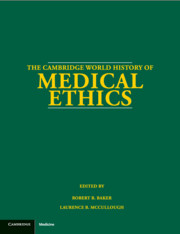Book contents
- Frontmatter
- PART I AN INTRODUCTION TO THE HISTORY OF MEDICAL ETHICS
- PART II A CHRONOLOGY OF MEDICAL ETHICS
- PART III DISCOURSES OF MEDICAL ETHICS THROUGH THE LIFE CYCLE
- PART IV THE DISCOURSES OF RELIGION ON MEDICAL ETHICS
- 9 The Discourses of Hindu Medical Ethics
- 10 The Discourses of Buddhist Medical Ethics
- 11 The Discourses of Confucian Medical Ethics
- 12 The Discourses of Early Christian Medical Ethics
- 13 The Discourses of Orthodox Christian Medical Ethics
- 14 The Discourses of Roman Catholic Medical Ethics
- 15 The Discourses of Protestant Medical Ethics
- 16 The Discourses of Jewish Medical Ethics
- 17 The Discourses of Islamic Medical Ethics
- PART V THE DISCOURSES OF PHILOSOPHY ON MEDICAL ETHICS
- PART VI THE DISCOURSES OF PRACTITIONERS ON MEDICAL ETHICS
- PART VII THE DISCOURSES OF BIOETHICS
- PART VIII DISCOURSES ON MEDICAL ETHICS AND SOCIETY
- Appendix: Biographies: Who Was Who in the History of Medical Ethics
- Bibliography
- Index
10 - The Discourses of Buddhist Medical Ethics
from PART IV - THE DISCOURSES OF RELIGION ON MEDICAL ETHICS
Published online by Cambridge University Press: 28 May 2012
- Frontmatter
- PART I AN INTRODUCTION TO THE HISTORY OF MEDICAL ETHICS
- PART II A CHRONOLOGY OF MEDICAL ETHICS
- PART III DISCOURSES OF MEDICAL ETHICS THROUGH THE LIFE CYCLE
- PART IV THE DISCOURSES OF RELIGION ON MEDICAL ETHICS
- 9 The Discourses of Hindu Medical Ethics
- 10 The Discourses of Buddhist Medical Ethics
- 11 The Discourses of Confucian Medical Ethics
- 12 The Discourses of Early Christian Medical Ethics
- 13 The Discourses of Orthodox Christian Medical Ethics
- 14 The Discourses of Roman Catholic Medical Ethics
- 15 The Discourses of Protestant Medical Ethics
- 16 The Discourses of Jewish Medical Ethics
- 17 The Discourses of Islamic Medical Ethics
- PART V THE DISCOURSES OF PHILOSOPHY ON MEDICAL ETHICS
- PART VI THE DISCOURSES OF PRACTITIONERS ON MEDICAL ETHICS
- PART VII THE DISCOURSES OF BIOETHICS
- PART VIII DISCOURSES ON MEDICAL ETHICS AND SOCIETY
- Appendix: Biographies: Who Was Who in the History of Medical Ethics
- Bibliography
- Index
Summary
INTRODUCTION
There are three major branches of Buddhism called Theravāda, Mahāyāna, and Vajrayāna. Although they developed sequentially in India, they eventually overlapped and all spread beyond India's borders. Over time, Theravāda became associated primarily with Sri Lanka and Southeast Asia, Mahāyāna with East Asia, and Vajrayāna with Tibet. Buddhism died out in India, the land of its birth circa 1300, although it has been making a comeback in the modern period with its conversion of the Dalits.
Buddhism denies a Supreme Being or Absolute. It also denies revelation. Its concept of enlightenment is based on insight into the very nature of reality framed by the law of karma (the law of reaping what one sows) and cosmic and individual cycles of existence (saṃsāra). Its doctrines of no-soul (anātman), impermanence (anitya), and becoming (pratītya-samutpāda) collectively produce a spiritual existentialism, which has as its sacred authority the experience of liberation (nirvāṇa). As in Hinduism (see Chapter 9), religion, philosophy, and medicine have been integrated into a “way of life” and telos that include both spiritual and rational orientations.
The place of ethics in Buddhism, however, is hotly debated. There are two prevailing views. One is that the Buddha's teachings and path are provisional, a raft to be eventually left behind. In this view, ethics (rules and virtues) are instrumental, and epistemology has two levels (provisional knowledge and truth). As a result, ethics cannot be made into absolute or universal rules and enlightenment is not characterized by goodness.
- Type
- Chapter
- Information
- The Cambridge World History of Medical Ethics , pp. 185 - 194Publisher: Cambridge University PressPrint publication year: 2008

